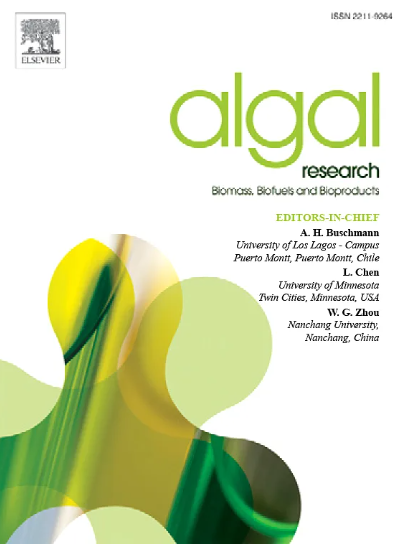三种氟喹诺酮类药物的剂量-响应模式及剂量、生长、毒性和吸收的因果关系
IF 4.5
2区 生物学
Q1 BIOTECHNOLOGY & APPLIED MICROBIOLOGY
Algal Research-Biomass Biofuels and Bioproducts
Pub Date : 2025-06-09
DOI:10.1016/j.algal.2025.104133
引用次数: 0
摘要
氟喹诺酮类抗生素作为新兴的微污染物,已被证明对水生植物的生长具有抑制作用。相反,这些受影响的植物同时表现出FQ吸收能力。然而,大型藻类对FQs的反应模式和去除效率,以及这些过程之间的因果关系尚不清楚。本研究研究了0 ~ 128 mg/L剂量的诺氟沙星、恩诺沙星和洛美沙星对长尾草的生长和毒性反应。72h后测定海水中FQ残留浓度。采用结构方程模型探讨初始剂量、藻类反应和FQ吸附之间的关系。不同FQ照射条件下,异枝田鼠的生长响应模式均服从辐射效应,呈钟形或Hill型剂量响应曲线。FQs对G. heteroclada表现出有限的毒性,96 h前大多数毒性曲线显示抑制率为50%,72 h后FQ去除率为54.18%±6.10% ~ 97.93%±0.17%。诺氟沙星去除率最高,恩诺沙星去除率最低。生长响应是直接影响FQ吸附的主要因素(回归系数为7.044),毒性与FQ吸附呈负相关(回归系数为- 1.683)。比生长速率是去除率和末端浓度的因果关系,比生长速率的抑制率是重要的中介变量。这些结果表明,环境中微量的FQ水平可以促进G. heteroclada的生长,而G. heteroclada对高浓度FQ表现出较强的耐受性。然而,在环境相关剂量和急性暴露下,去除效率降低限制了生物修复的应用,而慢性暴露风险需要进一步的生态毒性评估。本文章由计算机程序翻译,如有差异,请以英文原文为准。

Dose-response pattern of marine macroalgae Gracilariopsis heteroclada to three fluoroquinolones and the cause-effect relationship of dose, growth, toxicity and sorption
Fluoroquinolone (FQ) antibiotics, as emerging micropollutants, have been shown to inhibit the growth of aquatic plants. Conversely, these affected plants simultaneously exhibit FQ uptake capacity. However, the response patterns and removal efficiency of macroalgae exposed to FQs, and the cause-effect relationships between these processes, remain unclear. This study investigated the growth and toxicity responses of Gracilariopsis heteroclada to norfloxacin, enrofloxacin, and lomefloxacin over 96 h exposure at doses of 0–128 mg/L. Residual FQ concentrations in seawater were determined after 72 h. Structural equation modeling was applied to explore the relationships between initial dose, algal responses, and FQ sorption. Growth response patterns of G. heteroclada under each FQ exposure followed hormetic effects, with bell-shaped or Hill dose-response curves. FQs exhibited limited toxicity to G. heteroclada, with most toxicity curves indicating a lack of 50 % inhibition before 96 h. After 72 h, FQ removal rates ranged from 54.18 % ± 6.10 % to 97.93 % ± 0.17 %. Norfloxacin showed the highest removal rate and enrofloxacin the lowest. Growth response was the primary factor directly influenced FQ sorption (regression coefficient: 7.044), while toxicity had an inverse effect (−1.683). The specific growth rate acted as both cause and effect of the removal rate and terminal concentration, and the percent inhibition of the specific growth rate served as an important mediating variable. These findings suggest that environmental trace levels of FQs can stimulate the growth of G. heteroclada, which demonstrated strong tolerance to high FQ concentrations. However, reduced removal efficiencies at environmentally relevant doses and acute exposure constrain bioremediation applications, while chronic exposure risks necessitate further ecotoxicity assessments.
求助全文
通过发布文献求助,成功后即可免费获取论文全文。
去求助
来源期刊

Algal Research-Biomass Biofuels and Bioproducts
BIOTECHNOLOGY & APPLIED MICROBIOLOGY-
CiteScore
9.40
自引率
7.80%
发文量
332
期刊介绍:
Algal Research is an international phycology journal covering all areas of emerging technologies in algae biology, biomass production, cultivation, harvesting, extraction, bioproducts, biorefinery, engineering, and econometrics. Algae is defined to include cyanobacteria, microalgae, and protists and symbionts of interest in biotechnology. The journal publishes original research and reviews for the following scope: algal biology, including but not exclusive to: phylogeny, biodiversity, molecular traits, metabolic regulation, and genetic engineering, algal cultivation, e.g. phototrophic systems, heterotrophic systems, and mixotrophic systems, algal harvesting and extraction systems, biotechnology to convert algal biomass and components into biofuels and bioproducts, e.g., nutraceuticals, pharmaceuticals, animal feed, plastics, etc. algal products and their economic assessment
 求助内容:
求助内容: 应助结果提醒方式:
应助结果提醒方式:


